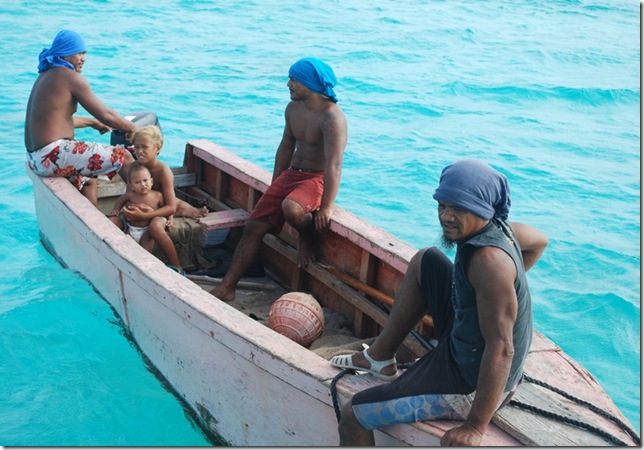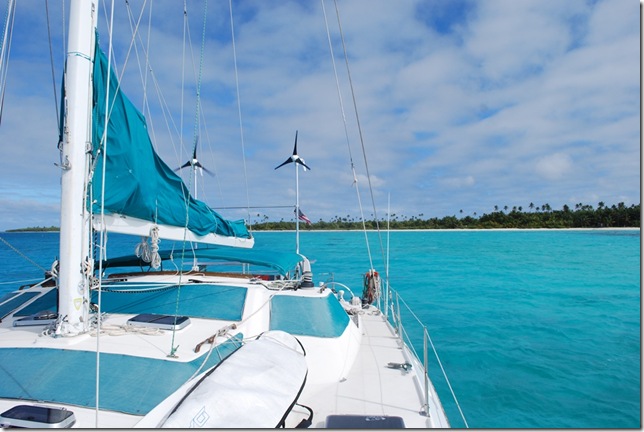Lat: 16 46.738′ S
Lon: 153 56.869′ W
Lauren and I started our last full day in Bora Bora with a snorkel trip to the “coral garden” around the point. I stayed at the surface on account of my ear, which has shown no improvement, but was able to enjoy things nonetheless. The coral wasn’t much to see, but there were a lot of colorful smaller fish that are evidently used to being fed, as many of them swarmed around us. There were also several schools of a light-colored fish that were laying in groups on the bottom, like they were having an afternoon nap. I’m still a little bummed about being diving-disabled in Bora Bora, but as Dr. Duval pointed out, I can’t complain too much, as there should be plenty of other dive opportunities.
Next we headed into town to do some shopping, including buying duty-free diesel, one of the few reasonably priced items to be found here. When we got to the fuel dock in the dinghy with our fuel jugs, we found a boat from the anchorage we’d just left along with a friend of theirs with a dinghy full of fuel jugs. The woman’s first question to Lauren was, “Does Dallas have the correct papers for the duty free fuel?” Evidently we’ve been fortunate in that even though the authorities in Papeete were feuding as I stood there, they managed to give me all the correct papers, unlike some other people we’ve meet. The other cruisers at the dock were missing one of the 4 papers that are required (the duty-free diesel permit alone isn’t enough), so I ended up using my papers to buy fuel for all of us.
Next we were off to the marine store to pick up a handheld VHF. One of ours was stolen from Lauren’s backpack in the Galapagos (where they retail for about $400) and our second one just died, which makes sharing a dinghy a little difficult. We also made the obligatory stop at the grocery store to stock up and grab some snacks and stopped at the hardware store for some boat project items.
Duty-free diesel is only about $3/gal, which feels like next to free, so the next morning, after topping off with water and emptying trash at the Bloody Mary’s dock, we headed back to the fuel dock to fill our jugs again, as all the diesel we’d bought the day before had been put into the tanks. This was our third visit to the gas station, and the woman who was a bit short and speaking French-only the first time we came and didn’t have enough cash was now very friendly, broke out reasonable English, and volunteered to combine our diesel purchases from the last couple of days so we didn’t have to do more paperwork. It really helps to smile and know how to say hello in the local language (“Yo-rana”). Our diesel tanks are now topped off and we have extra fuel in the jugs.
There are a couple of things I thought were interesting about Bora Bora that haven’t made it into a blog yet. One is that having reached the end of French Polynesia, we have yet to see a Polynesian wearing eyeglasses. We asked Moana about it in Ua Pou and he seemed to indicate that Polynesians had genetically good eyesight. I’ve mentioned it to another cruising couple and they couldn’t recall ever seeing a Polynesian with eyeglasses either. Another thing that seems to be unique to Bora Bora are go-fast boats with a complete disregard for anchored sailboats. The private boats and dive boats will buzz through an anchorage at a pretty high speed, sometimes within one boat length of anchored boats, which gets a little frustrating if you’re in the water working on the boat or in the middle of something that doesn’t like to be shaken up. Apparently because of all of the clear water and visible rocks and coral heads, the speedboats here have a unique design. Instead of sitting in the back of the boat, the driver sits on a seat in the bow of the boat and steers with a lever that moves left and right. Presumably, the forward helm station makes it easier to see the path that should be steered, but it’s the first time I’ve seen a design like that.
We weren’t the only boat that picked this window to leave. The VHF was crackling with boats hailing each other to check on conditions, arrange radio rendez-vous, and wish each other good trip. As we headed out the pass and set our sails, we could see at least five other boats heading out for different points west. Even in a gathering spot like Bora Bora, that feels like a virtual armada of cruising boats setting out.
We set a course for Mopelia, a small atoll we learned about from Jerome and Antoine while we were in Kauehi. It has the narrowest, supposedly most nerve-wracking pass in French Polynesia and is inhabited by between 3 and 20 people at a time.
The weather forecast called for moderate winds, followed by shifting light winds, before filling in from the southeast. Everything worked out as forecast, but we got a bit more wind and steep seas on the beam than we were expecting after things filled in during the early morning hours. Lauren did a good job on her watch of stowing all of the fuel and water jugs that had been sitting on the side decks and doing their best to jump overboard when things started getting rough. All of us pretty much stayed horizontal unless we had to get up, but nobody got sick enough to do any fish feeding. With her typical iron stomach, Lauren of course managed to do a bit of cooking (telling me later about picking the dead weevils out of the pasta) and some reading.
Between motoring in the light winds and doing 6 knots on just the jib when the wind picked up, we made the 128 nm run to Mopelia in time to attempt the pass at an ideal time, with the sun at our backs to make it easier to see and avoid coral heads. For the first time ever, our Navionics charts were off. When I lined up to head into the narrow, churning pass, the charts showed us going straight onto the reef, with the pass off to port. Oh well, this isn’t exactly a hotbed of yachting activity and you’ve got to trust your eyeballs, especially with a pass like this. The pass has quite a reputation, and it is narrow (maybe 60 ft or so and we have a beam of 21 ft), with lots of current (we got lucky and only had about 3-4 knots or so) and jagged coral rock edges, but it’s deep enough, and we made it through only a few tense minutes after we made the irreversible commitment to go for it. Lauren and Tiff each kept a look out for rocks from the bows and I kept busy with the throttles up and the wheel spinning back and forth as each refracted wave tried to turn the boat.
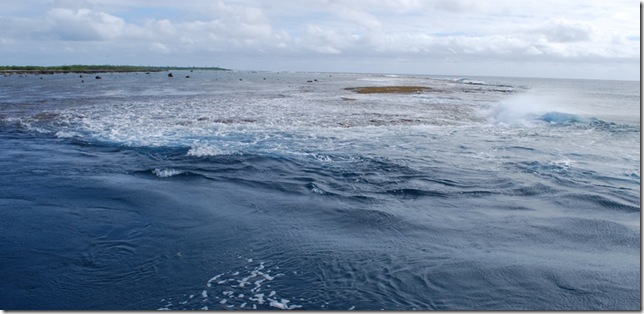 Current, rocks, and small breakers entering the pass
Current, rocks, and small breakers entering the pass
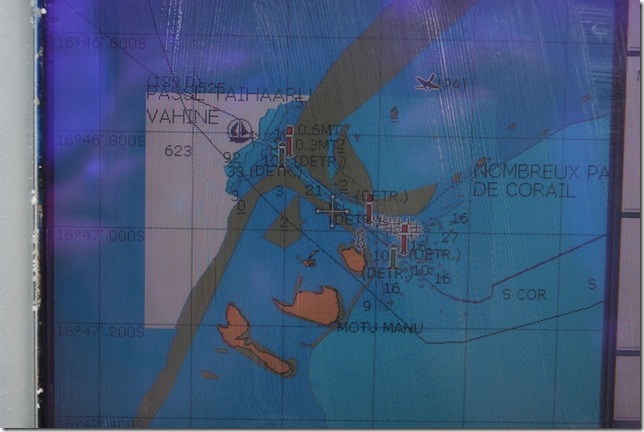 The bottom track shows the actual pass location
The bottom track shows the actual pass location
The atoll itself is incredibly beautiful. It is just a bit larger than 3 miles by 4 miles and sets NNW-SSE along the long axis. It has several motus, including a very large one that makes up the eastern side of the lagoon. A couple of the motus have small raised hills with greenery and coconut trees, while nice sandy beaches, and turquoise and soft blue water are everywhere. From our anchorage here on the northeast portion, we can see the spray thrown high up into the air as the swell crashes on the southern fringing reef 4 miles away. One of the motus is supposed to be a bird nesting site and the boat was surrounded by about a dozen large sea birds circling and swooping down near us as we approached the atoll.
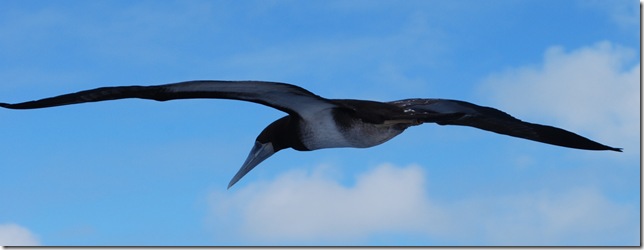 These guys were everywhere on the way in
These guys were everywhere on the way in
By the time we’d anchored and gotten settled, it was getting a bit close to dark for a shore visit, but we could see pigs wandering on the beach near a shack and home-built boat. Before long, a couple of guys got into the boat and headed our direction. They slowed near our stern and handed me two gutted, ready-to-eat parrotfish in a pan. The boat they came out on was a long and narrow home-built work boat with an outboard motor. Mounted on the bow was a nice sailing winch that they’d salvaged from a catamaran that is apparently wrecked on the reef near the pass. We’d heard that supply ships are pretty scarce here and that cigarettes are highly valued. Although none of us are smokers, Lauren and I had picked up a couple of packs before leaving Bora Bora. You should have heard the yelling and hollering that broke out when I told them we had cigarettes to trade for the fish. It was like they’d won the lottery. Tomorrow morning they’re bringing out lobster for the second pack. We asked how many people lived on the island, and they said two families. When we asked how many people that included, there was some finger-counting, a sort of confused look, and then we moved onto the next question.
Tiff did a great job preparing and cooking the fish, and we incorporated it into a fish burrito dinner that Wahoo’s would be proud of. There’s only one light on the island, barely visible for a couple of hours after sunset, coming from the dwelling on the beach that we saw earlier today. Other than that, it’s an overcast night and it would be hard to tell we were anchored all alone in a lagoon at all just by looking around.
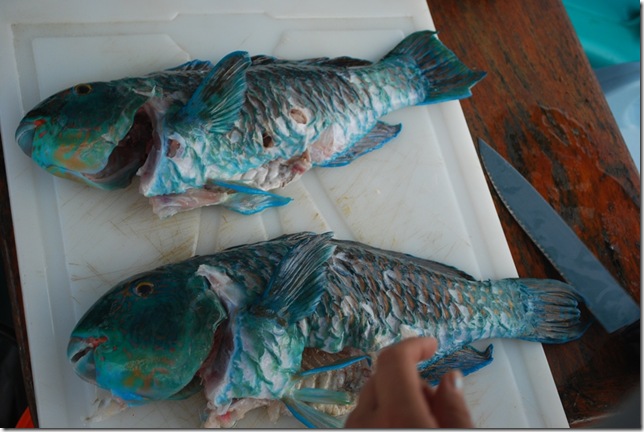 Parrot fish (in addition to the colors, the mouths really are like beaks)
Parrot fish (in addition to the colors, the mouths really are like beaks)
We’re probably headed out tomorrow to try to get to Aitutaki by the weekend, but this is definitely one of those virtually untouched places where it’s easy to linger and just take in the peace and natural beauty.


